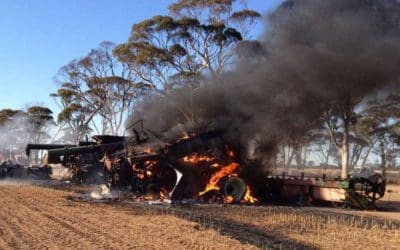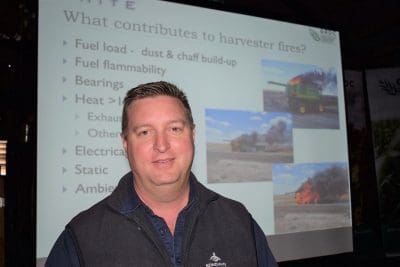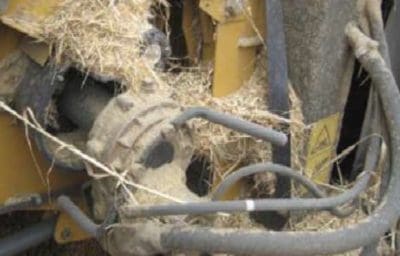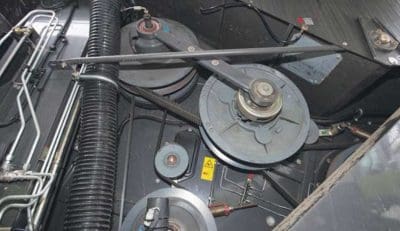THE surge in winter pulse crop plantings in recent years, coupled with the higher operating temperatures of modern-day, emissions-limiting headers, has increased the risk of harvester fires on Australian farms.
Speaking at the GRDC Grains Research Update at Jondaryan on Queensland’s Darling Downs, Western Australian-based Kondinin research general manager, Ben White, said while the risk had risen, most of the elements that led to fires on harvesting machinery could be monitored, maintained and addressed to avoid the problem.
Mr White said the major causes of fires on harvesters were bearing failures and dust and trash build-up on the machine. Together, these accounted for around half of harvester fires.
“Bearing failures are the ignition source; dust and trash build up are the fuel,” he said.
“I can’t stress enough the importance of keeping harvesters clean. In some cases you might need to stop every box and clean down.
“Fuel minimisation requires regular clean-downs of the machine, particularly in dusty crops and those that have suffered mould and disease.
“Start on the front and move to the top working down from there.”
Mr White said with 27 per cent of header fires started by bearing failure, it was critical for operators to monitor bearing temperatures.
“Buy an infra-red thermometer and monitor bearing temperatures, keeping a log of discrepancies. An infra-red temperature gun could be the best $50 you have spent,” he said.
Mr White said it was also important for operators to be aware of the flammability of various crops, particularly pulses such as chickpeas and lentils.
“Pulses are five times more prone to fire than wheat. They have a really fine, fibrous dust which is fantastic for starting fire,” he said.
“Some pulse crop plant material can ignite at temperatures as low as 130°C. While this can vary by seasonal conditions, there are plenty of components on a harvester that exceed this. In most cases much of the exhaust stream can exceed this.
“When you think about the parts of a harvester that could be over 130 degrees, there are a huge number of them.
“Particularly with newer machines that have all the emissions controls, there are engines that are running hotter. There are very hot components.”
Mr White said one of the factors people regularly blamed for starting harvester fires was static electricity, but he dismissed that as “largely a fallacy”.
“Static causing or starting a fire is a myth. There is not enough potential energy in a static spark to start a fire. While static may attract additional fuel all over the machine, potentially making fires worse, static discharge does not have sufficient energy to ignite crop dust.
“That brings us back to the importance of keeping dust and trash build up down.”
Mr White said at harvest, farmers should monitor the fire danger index (FDI) and cease harvesting if conditions deteriorated and the grass fire danger index (GFDI) approached 35.
“Always have plenty of fire-fighting equipment at hand in the paddock. I recommend 1000 litres of water, two fire extinguisher sets on the harvester; water (red) and an ABE – powder (white band around top of cylinder),” he said.
“I suggest having two extinguishers on the front and two up in the engine bay. If you go up into the engine bay and find a fire, the last thing you want to do is go back down the ladder and around the front to pick up an extinguisher.”
He said operators should also make sure their insurance covered everything on the harvester.
“There was an instance in WA where a contractor lost three harvesters. He thought he was adequately covered, but all his GPS and precision ag gear wasn’t,” he said.
Mr White said when it came to future developments on harvesters that would help prevent fires, manufacturers were unlikely to making significant changes.
“Australia constitutes a very small proportion of the world market for farm machinery and we are the only ones who harvest in the sort of conditions we harvest in. So, we are on our own when it comes to harvester fires,” he said.
“We need to get a good handle on where the hot components are on harvesters; we need to understand the emission temperatures and the agronomic influence much better than we do at the moment.”
Checklist for minimising risk
- Regular clean down
- Monitor bearings (e.g. temperature guns)
- Heat shield options (e.g. coatings, exhaust bandages, exhaust jackets)
- Electrical system maintenance and isolators (e.g. chaffed wiring)
- Fuel system maintenance (e.g. fuel and hydraulic lines rubbing)
- Maintaining airflow
- Reducing dust flow over exhaust (e.g. keep concave access doors sealed)
- Extinguishers on-machine and in-paddock
- Communications and having a plan
What if there is fire
- Pull out of the crop
- Get into a clear area
- Face into the wind
- Enact communications plan (e.g. let everyone know, get onto the fire authorities)
- Use appropriate extinguishers
Grain Central: Get our free daily cropping news straight to your inbox – Click here





HAVE YOUR SAY